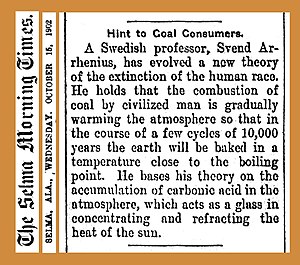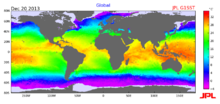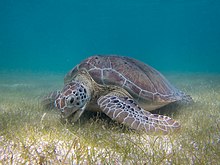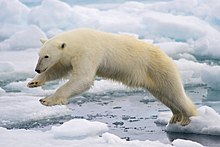Extinction risk from climate change
This article has multiple issues. Please help or discuss these issues on the talk page. (Learn how and when to remove these template messages)
|

The extinction risk of climate change is the risk of species becoming extinct due to the effects of climate change. Climate change is the long-term conversion of temperature and average weather patterns.[1] Currently, 19% of species on the IUCN Red List of Threatened Species are already being impacted by climate change.[2] Many studies have been conducted on how the effect of climate change can effect global temperatures and environment. Studies done by the Intergovernmental Panel on Climate Change (IPCC) show that it is estimated that the temperature will rise from about 1.4 to 5.5 degrees Celsius (2.5 to 10 degrees Fahrenheit) within the next century.[3] Temperature rise of 1.5 °C to 2.0 °C may see the geographic range of many insects, plants and vertebrates decrease significantly.[4] Efforts like Paris Agreement attempt to reduce further warming and help ecosystems adapt the effects of a rising temperature
Consensus on projections[]


The scientific consensus in the 2014 IPCC Fifth Assessment Report is that:
A large fraction of both terrestrial and freshwater species faces increased extinction risk under projected climate change during and beyond the 21st century, especially as climate change interacts with other stressors, such as habitat modification, over-exploitation, pollution, and invasive species. Extinction risk is increased under all RCP scenarios, with risk increasing with both magnitude and rate of climate change. Many species will be unable to track suitable climates under mid- and high-range rates of climate change during the 21st century. Lower rates of climate change will pose fewer problems.
— IPCC, 2014[7]
Some predictions of how life would be affected:
- Mediterranean Monk Seal: These animals have lost about 60% of their population in the past sixty years.
- Miombo Woodlands of South Africa: If the temperature were to rise by at least 4.5 degrees Celsius, this area would lose about 90% of its amphibians, 86% of birds, and 80% of mammals. Community forestry can mitigate and slow some of the changing vegetation associated with human caused deforestation. [8]
- The Amazon could lose 69 percent of its plant species.
- In southwest Australia 89 percent of amphibians could become locally extinct.
- 60 percent of all species are at risk of localised extinction in Madagascar.
- The Fynbos in the Western Cape Region of South Africa, which is experiencing a drought that has led to water shortages in Cape Town, could face localized extinctions of a third of its species, many of which are unique to that region." - WorldWildLife Fund
Temperature increase has affected and will continue to affect the amount of rainfall. Rain will fall in more extreme storms carrying more moisture.[9] This 'boom or bust' precipitation affects plant growth, and increasing temperature also leads to desertification. This would further spread in other issues including overgrazing and loss of biodiversity.[10]
Oceanic warming and acidification[]


The overall temperature of the ocean increases as a result of it absorbing most of the excess greenhouse gas emissions. When ocean temperatures rise, it affects the marine life and oceanic ecosystems. For example, increased ocean temperatures can cause coral bleaching and loss of breeding grounds for marine species. [11] Specifically, when carbon dioxide is absorbed into the ocean it forms bicarbonate and hydrogen ions. An increase in the amount of hydrogen ions is what causes ocean acidification because some marine life relies on those carbonate ions to grow their shells. Shellfish rely on the balanced pH of the ocean, if it gets more acidic than a pH of 7 (which is neutral) it could no longer be a suitable environment for sea creatures. It can be inferred that if these creatures don't have enough carbonate ions they will not be able to thrive. [12]
Extinction risks reported[]
2004[]
In one study published in Nature in 2004 found that between 15 and 37% of 1103 endemic or near-endemic known plant and animal species will be "committed to extinction" by 2050.[13] More properly, changes in habitat by 2050 will put them outside the survival range for the inhabitants, thus committing the species to extinction.
Other researchers, such as Thuiller et al.,[14] Araújo et al.,[15] Person et al.,[16] Buckley and Roughgarden,[17] and Harte et al.[18] have raised concern regarding uncertainty in Thomas et al.'s projections; some of these studies believe it is an overestimate, others believe the risk could be greater. Thomas et al. replied in Nature [19] addressing criticisms and concluding "Although further investigation is needed into each of these areas, it is unlikely to result in substantially reduced estimates of extinction. Anthropogenic climate change seems set to generate very large numbers of species-level extinctions." On the other hand, Daniel Botkin et al. state "... global estimates of extinctions due to climate change (Thomas et al. 2004) may have greatly overestimated the probability of extinction..."[20]
Mechanistic studies are documenting extinctions due to recent climate change: McLaughlin et al. documented two populations of Bay checkerspot butterfly being threatened by precipitation change.[21] Parmesan states, "Few studies have been conducted at a scale that encompasses an entire species"[22] and McLaughlin et al. agreed "few mechanistic studies have linked extinctions to recent climate change."[21]
2008[]
In 2008, the white lemuroid possum was reported to be the first known mammal species to be driven extinct by climate change. However, these reports were based on a misunderstanding. One population of these possums in the mountain forests of North Queensland is severely threatened by climate change as the animals cannot survive extended temperatures over 30 °C. However, another population 100 kilometres south remains in good health.[23]
2010[]
The risk of extinction does need to lead to a demonstrable extinction process to validate future extinctions attributable to climate change. In a study led by Barry Sinervo,[24] a mathematical-biologist at the University of California Santa Cruz, researchers analyzed observed contemporary extinctions (since dramatic modern climate warming began in 1975). Results of the study indicate that climate-forced extinctions of lizard families of the world have already started. The model is premised on the ecophysiological limits of an organism being exceeded. In the case of lizards, this occurs when their preferred body temperature is exceeded in their local environment. Lizards are ectotherms that regulate body temperature using heat sources of their local environment (the sun, warm air temperatures, or warm rocks). Surveys of 200 sites in Mexico showed 24 local extinctions (= extirpations), of Sceloporus lizards. Using a model developed from these observed extinctions the researchers surveyed other extinctions around the world and found that the model predicted those observed extirpations, thus attributing the extirpations around the world to climate warming. These models predict that extinctions of the lizard species around the world will reach 20% by 2080, but up to 40% extinctions in tropical ecosystems where the lizards are closer to their ecophysiological limits than lizards in the temperate zone.[25]
2012[]
According to research published in the January 4, 2012 Proceedings of the Royal Society B current climate models may be flawed because they overlook two important factors: the differences in how quickly species relocate and competition among species. According to the researchers, led by Mark C. Urban, an ecologist at the University of Connecticut, diversity decreased when they took these factors into account, and that new communities of organisms, which do not exist today, emerged. As a result, the rate of extinctions may be higher than previously projected.[26]
2014[]
According to research published in the 30 May 2014 issue of Science, most known species have small ranges, and the numbers of small-ranged species are increasing quickly. They are geographically concentrated and are disproportionately likely to be threatened or already extinct. According to the research, current rates of extinction are three orders of magnitude higher than the background extinction rate, and future rates, which depend on many factors, are poised to increase. Although there has been rapid progress in developing protected areas, such efforts are not ecologically representative, nor do they optimally protect biodiversity. In the researchers' view, human activity tends to destroy critical habitats where species live, warms the planet, and tends to move species around the planet to places where they do not belong and where they can come into conflict with human needs (e.g. causing species to become pests).[27][28]

According to a long-term study of more than 60 bee species published in the journal Science said that climate change effects drastic declines in the population and diversity of bumblebees across North America and Europe. This research showed that bumblebees are disappearing at rates "consistent with a mass extinction." North America's bumblebee populations fell by 46% during the two time periods the study used, which were from 1901 to 1974 and from 2000 to 2014. North America's bumblebee populations fell by 46% because bee populations were hardest hit in warming southern regions such as Mexico. According to the study, there have been more frequent extreme warm years, which exceeded the species’ historical temperature ranges.[29]
2016[]
In 2016, the Bramble Cay melomys, which lived on a Great Barrier Reef island, was reported to probably be the first mammal to become extinct because of sea level rises due to human-made climate change.[30]
Extinction risks of the Adelie penguin are being reported because of climate change. The Adelie penguin (Pygoscelis adeliae) species is declining and data analysis done on the breeding colonies is used to estimate and project future habitat and population sustainability in relation to warming sea temperatures. By 2060, one-third of the observed Adelie penguin colony along the West Antarctic Peninsula (WAP) will be in decline. The Adelie penguins are a circumpolar species, used to the ranges of Antarctic climate, and experiencing population decline. Climate model projections predict sanctuary for the species past 2099. The observed population is similarly proportional to the species-wide population (one-third of the observed population is equal to 20% of the species-wide population).[31]

Sex ratios for sea turtles in the Caribbean are being affected because of climate change. Environmental data were collected from the annual rainfall and tide temperatures over the course of 200 years and showed an increase in air temperature (mean of 31.0 degree Celsius). These data were used to relate the decline of the sex ratios of sea turtles in the North East Caribbean and climate change. The species of sea turtles include Dermochelys coriacea, Chelonia myads, and Eretmochelys imbricata. Extinction is a risk for these species as the sex ratio is being afflicted causing a higher female to male ratio. Projections estimate the declining rate of male Chelonia myads as 2.4% hatchlings being male by 2030 and 0.4% by 2090.[32]
2019[]
According to the World Wildlife Fund, the jaguar is already "near threatened" and the loss of food supplies and habitat due to the fires make the situation more critical.[33]
The fires affect water chemistry (such as decreasing the amount of dissolved oxygen in the water), temperature, and erosion rates, which in turn affects fish and mammals that depend on fish, such as the giant otter (Pteronura brasiliensis).[33]
2020[]
The unprecedented fires of the 2019–20 Australian bushfire season that swept through 18 million acres (7 million hectares) claimed 29 human lives and stressed Australia's wildlife.[34] Before the fires, only 500 tiny Kangaroo Island dunnarts (Sminthopsis aitkeni) lived on one island; after half the island was burned, it is possible only one survived. Bramble Cay melomys (Melomys rubicola) became the first known casualty of human-caused climate change in 2015 due to rising sea levels and repeated storm surges; the greater stick-nest rat (Leporillus conditor) may be next.[35]
Emus (Dromaius novaehollandiae) are not in danger of total extinction, although they might suffer local extinctions as a result of bushfires; in northern New South Wales, coastal emus could be wiped out by fire .[35] The loss of 8,000 koalas (Phascolarctos cinereus) in NSW alone was significant, and the animals are endangered but not functionally extinct.[36][37]
A February 2020 study found that one-third of all plant and animal species could be extinct by 2070 as a result of climate change.[38][39]

BBC reported on a 2020 study done saying that polar bears could go extinct by 2100 if nothing is done to address climate change. Arctic sea ice has been shrinking from the warming of the planet, polar bears rely on the sea ice to hunt seals so they don't have to go on the shore. The melting of sea ice could force polar bear populations to decrease rapidly. A 2020 study measured how polar bears "endurance limits" as they continue to run out of food and prove to have a difficult time adapting to the warmer Arctic temperatures. The amount of sea ice that survives for longer than a year has been decreasing by about 13% per decade since the 1970s.[40]
See also[]
- Atelopus varius
- Chytridiomycosis
- Ecosystem services
- Gastric-brooding frog
- Golden toad
- Guajira stubfoot toad
- Keystone species
- Paleocene–Eocene Thermal Maximum
- Risks to civilization, humans, and planet Earth
References[]
- ^ "Climate Change". National Geographic. 28 March 2019. Retrieved 1 November 2021.
- ^ "Species and Climate Change". IUNC. IUNC. 4 December 2019. Retrieved 7 April 2021.
- ^ "The Effects of Climate Change". Global Climate Change Vital Signs of the Planet. NASA. Retrieved 7 April 2021.
- ^ Website, By Alan Buis NASA's Global Climate Change. "A Degree of Concern: Why Global Temperatures Matter". Climate Change: Vital Signs of the Planet. Retrieved 10 July 2021.
- ^ "Summary for Policymakers". Climate Change 2021: The Physical Science Basis. Working Group I contribution to the WGI Sixth Assessment Report of the Intergovernmental Panel on Climate Change (PDF). Fig. SPM.6: Intergovernmental Panel on Climate Change. 9 August 2021. p. SPM-23. Archived (PDF) from the original on 4 November 2021.CS1 maint: location (link)
- ^ "Hint to Coal Consumers". The Selma Morning Times. Selma, Alabama, US. October 15, 1902. p. 4.
"Carbonic acid" refers to carbon dioxide when dissolved in water. - ^ Field, Christopher B.; et al., eds. (29 December 2014). Climate change 2014 : impacts, adaptation, and vulnerability. ISBN 9781107641655. OCLC 928427060.
- ^ Z. J. Lupala, L. P. Lusambo, Y. M. Ngaga, Angelingis A. Makatta, "The Land Use and Cover Change in Miombo Woodlands under Community Based Forest Management and Its Implication to Climate Change Mitigation: A Case of Southern Highlands of Tanzania", International Journal of Forestry Research, vol. 2015, Article ID 459102, 11 pages, 2015. https://doi.org/10.1155/2015/459102
- ^ Witze, Alexandra. "Why extreme rains are gaining strength as the climate warms". Nature. Retrieved 30 July 2021.
- ^ Committee of the Regions; Aston University. Aston Centre for Europe (2011). The relationship between desertification and climate change in the Mediterranean (PDF). Publications Office. doi:10.2863/63777. ISBN 9789289506434.
- ^ Laffoley, D (2016). "Ocean warming". IUCN. Retrieved 2 November 2021.
- ^ "CO2 and Ocean Acidification: Causes, Impacts, Solutions". Union of Concerned Scientists. 30 January 2019. Retrieved 3 November 2021.
- ^ Thomas CD, Cameron A, Green RE, Bakkenes M, Beaumont LJ, Collingham YC, Erasmus BF, De Siqueira MF, Grainger A, Hannah L, Hughes L, Huntley B, Van Jaarsveld AS, Midgley GF, Miles L, Ortega-Huerta MA, Peterson AT, Phillips OL, Williams SE (January 2004). "Extinction risk from climate change". Nature. 427 (6970): 145–8. Bibcode:2004Natur.427..145T. doi:10.1038/nature02121. PMID 14712274. S2CID 969382.
- ^ Thuiller W, Araújo MB, Pearson RG, Whittaker RJ, Brotons L, Lavorel S (July 2004). "Biodiversity conservation: uncertainty in predictions of extinction risk". Nature. 430 (6995): 1 p following 33, discussion following 33. doi:10.1038/nature02716. PMID 15237465. S2CID 4387678.
- ^ Araújo MB, Whittaker RJ, Ladle RJ, Erhard M (2005). "Reducing uncertainty in projections of extinction risk from climate change". Global Ecology and Biogeography. 14 (6): 529–538. doi:10.1111/j.1466-822X.2005.00182.x.
- ^ Pearson RG, Thuiller W, Araújo MB, Martinez-Meyer E, Brotons L, McClean C, Miles L, Segurado P, Dawson TP, Lees DC (2006). "Model-based uncertainty in species range prediction". Journal of Biogeography. 33 (10): 1704–1711. doi:10.1111/j.1365-2699.2006.01460.x.
- ^ Buckley LB, Roughgarden J (July 2004). "Biodiversity conservation: effects of changes in climate and land use". Nature. 430 (6995): 2 p following 33, discussion following 33. doi:10.1038/nature02717. PMID 15233130. S2CID 4308184.
- ^ Harte J, Ostling A, Green JL, Kinzig A (July 2004). "Biodiversity conservation: climate change and extinction risk". Nature. 430 (6995): 3 p following 33, discussion following 33. doi:10.1038/nature02718. PMID 15237466. S2CID 4431239.
- ^ Thomas CD, Williams SE, Cameron A, Green RE, Bakkenes M, Beaumont LJ, Collingham YC, Erasmus BF, Ferriera de Siqueira M, Grainger A, Hannah L (2004). "Uncertainty in predictions of extinction risk/Effects of changes in climate and land use/Climate change and extinction risk (reply)". Nature. 430 (6995): 34. doi:10.1038/nature02719. S2CID 4430798.
- ^ Botkin DB, Saxe H, Araujo MB, Betts R, Bradshaw RH, Cedhagen T, Chesson P, Dawson TP, Etterson JR, Faith DP, Ferrier S (2007). "Forecasting the Effects of Global Warming on Biodiversity". BioScience. 57 (3): 227–236. doi:10.1641/B570306.
- ^ a b McLaughlin JF, Hellmann JJ, Boggs CL, Ehrlich PR (April 2002). "Climate change hastens population extinctions". Proceedings of the National Academy of Sciences of the United States of America. 99 (9): 6070–4. Bibcode:2002PNAS...99.6070M. doi:10.1073/pnas.052131199. PMC 122903. PMID 11972020.
- ^ Parmesan C (2006). "Ecological and Evolutionary Responses to Recent Climate Change". Annual Review of Ecology, Evolution, and Systematics. 37: 637–669. doi:10.1146/annurev.ecolsys.37.091305.110100.
- ^ Nowak R (31 March 2009). "Rumours of possum's death were greatly exaggerated". New Scientist.
- ^ Sinervo B., F. R. Méndez-de-la-Cruz, D. B. Miles, et al. 2010. Erosion of lizard diversity by climate change and altered thermal niches. Science, 324:894-899.
- ^ Huey, R. B., Deutsch, C. A., Tewksbury, J. J., Vitt, L. J., Hertz, P. E., Álvarez Pérez, H. J., & Garland Jr, T. (2009). Why tropical forest lizards are vulnerable to climate warming. Proceedings of the Royal Society B: Biological Sciences, 276(1664), 1939-1948.
- ^ Parry W (6 January 2012). "Climate change models flawed, extinction rate likely higher than predicted". csmonitor.com.
- ^ Pimm SL, Jenkins CN, Abell R, Brooks TM, Gittleman JL, Joppa LN, Raven PH, Roberts CM, Sexton JO (May 2014). "The biodiversity of species and their rates of extinction, distribution, and protection". Science. 344 (6187): 1246752. doi:10.1126/science.1246752. PMID 24876501. S2CID 206552746.
- ^ Sreenivasan H, Pimm S (1 June 2014). "New report suggests Earth on the brink of a great extinction". PBS NewsHour.
- ^ "Bumblebees are disappearing at rates 'consistent with mass extinction'". Retrieved 3 November 2020.
- ^ Smith L (2016-06-15). "Extinct: Bramble Cay melomys". Australian Geographic. Retrieved 2016-06-17.
- ^ Cimino MA, Lynch HJ, Saba VS, Oliver MJ (June 2016). "Projected asymmetric response of Adélie penguins to Antarctic climate change". Scientific Reports. 6: 28785. Bibcode:2016NatSR...628785C. doi:10.1038/srep28785. PMC 4926113. PMID 27352849.
- ^ Laloë JO, Esteban N, Berkel J, Hays GC (2016). "Sand temperatures for nesting sea turtles in the Caribbean: Implications for hatchling sex ratios in the face of climate change". Journal of Experimental Marine Biology and Ecology. 474: 92–99. doi:10.1016/j.jembe.2015.09.015.
- ^ a b Hira Humayun (Aug 28, 2019). "What the Amazon's fires mean for its animals". CNN World. Retrieved Feb 8, 2020.
- ^ David Millikin (Jan 20, 2020). "Australia fires 'devastating habitats' of endangered species". Phys.org. Retrieved Feb 8, 2020.
- ^ a b Ed Yong (Jan 14, 2020). "The Bleak Future of Australian Wildlife". The Atlantic. Retrieved Feb 8, 2020.
- ^ Danush Parvaneh; Christophe Haubursin; Melissa Hirsch (Jan 14, 2020). "Are Australia's koalas going extinct? We asked an ecologist". Vox. Retrieved Feb 8, 2020.
- ^ Natasha Daly (Nov 25, 2019). "No, koalas aren't 'functionally extinct'—yet". National Geographic. Retrieved Feb 8, 2020.
- ^ Román-Palacios C, Wiens JJ (2020). "Recent responses to climate change reveal the drivers of species extinction and survival". PNAS. 117 (8): 4211–4217. doi:10.1073/pnas.1913007117. PMC 7049143. PMID 32041877.
- ^ Rice, Doyle (February 14, 2020). "One-third of all plant and animal species could be extinct in 50 years, study warns". USA Today. Retrieved February 15, 2020.
- ^ Briggs, H (20 July 2020). "Climate change: Polar bears could be lost by 2100". BBC. Retrieved 6 November 2021.
External links[]
- MacKenzie D (18 May 2011). "Calculations may have overestimated extinction rates". New Scientist.
- Root T, Pimm S (9 June 2014). "Recent Research Shows Human Activity Driving Earth Towards Global Extinction Event". The Real News Network. Archived from the original on 9 June 2014.
- PA Media (6 February 2020). "Bumblebees' decline points to mass extinction – study". The Guardian. London.
- "Half of plant and animal species at risk from climate change in world's most important natural places". 14 March 2018.
- Corporativa, Iberdrola. "Climate Change Is Accelerating the Sixth Extinction". Iberdrola.
- "The Effects of Climate Change". NASA. 21 August 2020.
- Doomsday scenarios
- Environmental conservation
- Extinction
